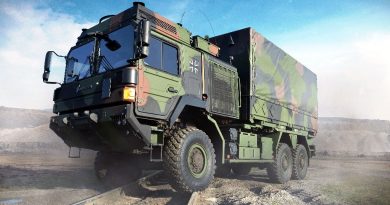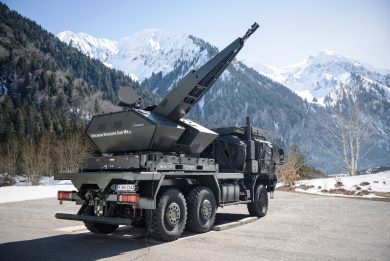Eurosatory 2024 – Rheinmetall: looking beyond the Panther KF51
Two years ago, Rheinmetall unveiled its Panther KF51 main battle tank. At Eurosatory 2024 the German company announces its plans to move further ahead on the development of that tank and on exploiting the work done for proposing solutions for potential tank upgrades
Definitely the star at the 2022 edition of Eurosatory, Rheinmetall’s Panther KF51 main battle tank has evolved in the last two years, the company bringing at this year Paris event a series of options, some of them still at concept stage, to exploit the development work done on the new MBT.
In December last year Hungary filed a Euro 288 million contract to develop the Panther to production maturity. The aim is to get the Panther ready for production, the project being carried out in cooperation with N7, the Hungarian state-owned holding company that also holds 49% of the Rheinmetall Hungary joint venture. Known as Panther KF51 EVO, its main armament will be the L55A1 120 mm smoothbore gun which is being modified in order to be interfaced with the bustle-mounted automatic loader. This remains the one developed for the Panther and will host 20 120 mm ammunition in two separate 10-round magazines, right and left of the bustle, the central part hosting the loading system; it is to note that 10 additional rounds can be stored in the vehicle. Should the customer decide to switch to the bigger calibre gun, this will be done easily, the work taking around two weeks at the company workshop Alexander Kuhrt, Head of Product Portfolio Tracked Vehicles at Rheinmetall told EDR On-Line.
Beside the Hungarian contract, Rheinmetall is looking with interest at the Leopard 2 users, and is proposing an upgrade of their tanks, by replacing the turret with that of the Panther. As the 120 mm gun autoloader-compatible is already under development, here too the customer might select the L55A1 120 mm gun while maintaining an open option for a further smooth transition to the 130 mm calibre. Not only, as new production tanks require between 24 and 36 months at best to be delivered, such an upgrade option might provide a state-of-the-art MBT available at short term; the number of rounds remains the same in the 120 and 130 mm configurations, while the protection level is higher than that of Leopard 2s, and includes passive, reactive and active armour. The fire control system is an improved version of that used in the latest Leopard 2 versions.
At Eurosatory this solution is visually obvious, the Leopard 2A4 chassis maintaining the typical grey camouflage while the turret sports the Rheinmetall digital pattern, typically used on the company prototypes.
The last proposal by Rheinmetall is also the most interesting in the long term, as currently it is only at concept stage. The Düsseldorf-based company started the development of an uncrewed turret for MBTs. This solution, known as Concept Uncrewed Turret (CUT) will require an updated chassis, as the three-man crew would sit side by side in the hull ahead of the turret, EDR On-Line understanding that all external vision will be provided by images captured by day/night cameras, no details being provided on how those will be presented to the crew, via screens or head-mounted displays for example. What is sure is that to cope with driving constraints as well as with observation, acquisition and aiming, those systems will feature an extremely low latency. The IFV Puma being fitted with an uncrewed turret, several lessons learned have been acquired and will be considered in the new unmanned turret concept. Coming to the turret, this differs under several aspects from manned turrets installed on current MBTs. The turret uses the same main 130 mm smoothbore gun and its automatic loader as the Panther KF51, however five spare rounds will be available in the turret, bringing the total on-board ammunition to 25. The turret will maintain the capability to swap one of the 10-round ammo magazines of the autoloader for a loitering munitions launcher.
A new main gunner sight is installed on the right side of the turret; the new SEOSS 400 (Stabilized Electro-Optical Sighting System). Should the system fail, a backup direct view sight is installed just over the gun. The same SEOSS 400 will be at the heart of the commander’s sight, which includes a Main Sensor Slaved Armament (MSSA) based on the RMG 7.62 three-barrel machine gun developed in the past years by Rheinmetall, a C-UAS radar and smoke dispensers. This ensemble forms a remotely controlled weapon station which is installed at the front-left of the turret. The unmanned turret is equipped with a same 12.7 mm coaxial machine gun. The SEOSS 400 development roadmap follows that of the unmanned turret, the new system planned to be ready at the right time. Leveraging the experience acquired with the EMES 50 installed on the Leopard 2 and on the SEOSS 300 that equips the Lance turret, the new system will ensure longer ranges both with its thermal and daylight sensors, while having a much reduced height to cope with the low silhouette requirement. It will be fitted with an automatic target recognition system, currently under development. The commander being able to take over the firing from the gunner, the turret will provide both hunter-killer and killer-killer capabilities, the same being true also for the overall commander’s RCWS/sight ensemble.
Coming to protection, no data about levels were provided. According to Mr. Kuhrt these will be discussed with each single customer, however EDR On-Line understood that a good protection level should be maintained especially in the ammunition area. Sources told us that a mass reduction of 10-20% of compared to manned turrets should be obtained. This means well over 1,000 kg in the best option, a bonus that might be used to add further systems to the tank. As for dimensions, as these are mostly dictated by the autoloader at the rear and by the gun elevation limits, the unmanned turret size is close to that of the manned one,
The turret will have the two Elbit Systems Iron Fist active protection system trainable launchers on the sides, radar sensors being located at the four corners of the turret itself, together with the sensors of the Rheinmetall SAS (Situational Awareness System). On the top-right we find the container/launcher of the near-field reconnaissance or combat UAS, similar to those seen at Eurosatory 2022. Also on both sides, in front and at the rear of the Iron-Fist launcher, we find smoke grenade dispensers each with four tubes, for a total of 16 ready-to-fire grenades. An acoustic gunshot detection sensor, a meteorological sensor and antennas are visible on the top rear of the turret.
Of course, that configuration may vary, the project being still in its infancy. According to Rheinmetall the new concept turret is currently at TRL 5, however technologies involved as well as most of the subsystems are already mature, therefore the company considers it a low-risk development. The development took into consideration requirements coming from different sources, the German BAAINBw, the MGCS programme and the European Defence Fund MBT study.
By unveiling the unmanned turret, Rheinmetall is aiming at getting comments from potential customers, some of them having already expressed interest in such a solution, leading to the launch of the concept development phase. How much the various customers requirements will converge, allowing to step to the next phase that will bring to a prototype remains to be seen.
Photos by P. Valpolini









